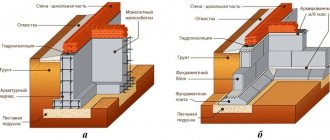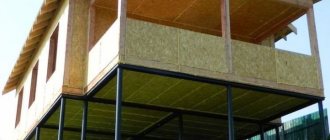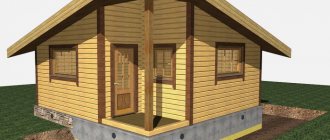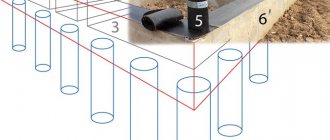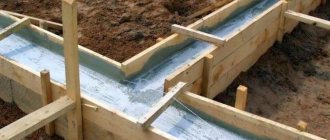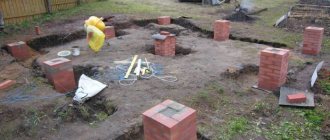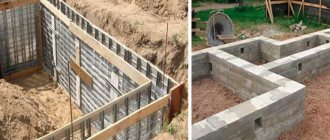Why do you need a base underlay?
It's no secret that a poorly laid foundation will make life in the house impossible. If the foundation is installed incorrectly, the walls of the building will crack, door and window openings will become distorted, and drafts will permanently settle inside the home. That is why the construction of the foundation must be carried out in compliance with the technology, a mandatory item of which is a pillow under the strip foundation. This load-bearing element will correctly distribute the load from the walls of the house onto the ground and prevent its subsidence. It also helps to raise the lower part of the support above the groundwater level.
Construction of the base on a sand cushion
Why do you need geotextiles for the foundation?
To clearly understand what the advantages of this material are, it is advisable to consider the directions of the functions performed. Geotextiles under the foundation (as a substrate) perform a number of tasks.
Waterproofing
It prevents moisture from entering the base of the building, or filters water, prevents silting, prevents small particles from entering the drainage system filler, and contributes to its efficient operation and durability. In this case, geotextile is wrapped around the drainage pipe and filler.
Soil reinforcement
With the correct density, the material enhances its strength, helping to increase the bearing capacity of the soil. For example, if there is a risk of soil swelling under a shallow foundation, 40-80 cm of soil is removed and replaced with crushed stone or sand. Geotextiles are laid under a layer of non-metallic material - this is the most affordable and easiest way to strengthen the soil and avoid mixing, the formation of voids and failures. In winter, geotextiles protect against frost heaving of the soil.
Laying geotextiles on clay soil under a one-story frame house 8*10 (30 tons)
Strengthening the protection and strength of concrete foundations
Geotextiles protect concrete surfaces from freezing and the damaging effects of moisture. Thin material is used, with a density of 100-150 g/m2.
Making your own pillow
In practice, several types of base are used:
- from sand;
- from gravel;
- made of sand and gravel (combined);
- made of concrete.
Combined backfill under a monolithic slab
To level the bottom of a trench or pit at the site of the future foundation, it is necessary to fill in a ten-centimeter layer of sand or gravel. Concreting is used where the base wall needs to be expanded or there is a need to reinforce the belt under FSB blocks. It’s not difficult to make a crushed stone bedding with your own hands; you just need to remember that the embankment should be lower than the base itself, and its width will be twice as large as the similar parameter of the foundation. The crushed stone backfill is usually about 30 cm, a third of which is sand, and two thirds is gravel .
Laying and leveling sand
After leveling the bottom of the pit, a cushion is built for the foundation. The process starts with laying a layer of sand, which is spilled with water and compacted. Gravel is laid in a similar way. To create a concrete support, it is necessary to pour a 5-10 cm layer of crushed stone onto a flat area, subject to mandatory compaction. Now we begin to install the formwork according to the dimensions of the fill, which needs to be reinforced along the length. At the end of the process, we pour concrete solution, which can be equipped with vertical reinforcement bars. This will make it possible to connect the monolithic support to the foundation.
It is correct to make a crushed stone cushion so that the finished base corresponds in level to the mark in the design documentation. The most reliable support for a foundation slab is a concrete pad . You can also build it yourself, although such a process will take a lot of time, and its cost will be higher due to the increase in the number of consumables. The thickness of this supporting platform should exceed the foundation by 30 cm, the same applies to the width (15 cm on each side).
The most reliable concrete support
Why does a foundation need bedding?
Those who are thinking about whether backfilling is needed for the foundation should take note that it is necessary to build a support for any building, especially a residential building, with high quality, and in compliance with all building codes and regulations. Only then will the doors of the house always close correctly, the walls will not become covered with cracks over time, and the window frames will not warp. A well-made bedding is the main guarantee of a strong, reliable and strong foundation, which will stand for many decades without the slightest hint of deterioration in its characteristics.
To construct a backfill for the foundation, you need to take those materials that meet certain requirements. The main ones can be formulated as follows:
- they should not be heaving;
- they should not contain flammable impurities and vegetation residues;
The key to a strong home is a quality foundation - even in a highly compacted state, they must drain water well;
- they should not change their properties due to moisture or during the process of freezing and thawing.
The most commonly used affordable and reliable bedding materials are:
- grit;
- gravelly sand (with medium-sized or coarse grains);
- gravel (shungizite, expanded clay);
- mixtures: sand, gravel, crushed stone;
- crushed stone
Sand backfill
A sand cushion for the foundation is the simplest and cheapest type of bedding, so it is chosen by those who want to save money, speed up the construction process and do it themselves . Although such a platform does not seem very reliable, it completely copes with the mission assigned to it. A sand cushion under the strip foundation saves the foundation from erosion and also ensures a permissible load on its lower part.
To make a good backfill, choose coarse sand and cover it with a layer of at least 20-25 cm.
The loose mass must be thoroughly leveled and compacted using a vibrating plate. When compacting, do not forget to flood the area with water for greater compaction.
As you already understand, the foundation cushion is made exclusively from coarse sand. On weak-bearing soils, sand alone is not enough, so the site is additionally reinforced with gravel. Such preparation for the foundation practically does not allow shrinkage after the construction of a massive house with any area, and that is why it is very important to carry out the compaction correctly, especially if you do all the work with your own hands.
Flaws
The terrain on the site for such a foundation must be level.
A floating foundation cannot be considered as a universal option for all construction projects.
Like any other foundation, it has disadvantages:
- not suitable for installation on construction sites with a slope;
- difficulties arise if you need to build a house with a basement on a foundation made of concrete slabs;
- problems may arise with the repair of communications carried out under the foundation;
- construction of a slab foundation in winter will require additional investments to warm up the cement mortar and maintain positive temperatures at the construction site.
The main disadvantage is the high price, so a floating foundation is used only when it is impossible to mount a strip foundation.
Gravel backfill
This base has a clear advantage over the previous one - it is stronger and more durable, since gravel acts as the main component here.
Construction of a reinforced concrete foundation
Before making a crushed stone backfill for the foundation slab, you need to cover the soil with coarse river sand (15 cm layer), which is evenly leveled and compacted. Then a layer of crushed stone (20-25 cm) is poured in and it is also compacted.
Carefully ensure that the pebbles fit snugly against each other and fill all the voids. To perform this process, you need a vibrating plate, otherwise it will not be possible to achieve the required density. Since the construction of the foundation will begin with a layer of crushed stone, the cushion should be at the zero level. This type of substrate is suitable for further construction of any type of structures made of various materials.
Conditions for choosing the right material
The choice of geotextile directly depends on the conditions of its further operation. Manufacturing technology, density, elasticity and waterproofing properties are taken into account. In this case, the main technical parameter and characteristic is the density of the material and, depending on this, polymer textiles are used:
- for the installation of drainage layers and moisture removal - 150-200 g/m2;
- to protect the foundation and as a separating layer between crushed stone and sand - 250-300 g/m2;
- to evenly distribute loads on the ground from building structures and create protection from the effects of heaving soils - from 350 g/m2.
Therefore, in order to find out what geotextile to use, it is necessary to accurately determine the design of the foundation and the technical problems that must be solved with the help of this material.
Characteristics of geotextiles.
Concrete cushion under a monolithic slab
Finally, let’s look at how to install a concrete platform with your own hands . This design has only one drawback - its high cost, but otherwise such a project consists of continuous advantages.
Construction of a monolithic base slab
First of all, I would like to note the durability of the pillow, provided that the installation work is carried out correctly, and they look like this:
- The area is cleared of plants and debris.
- The soil is carefully leveled.
- Crushed stone is laid in a layer up to 10 cm thick.
- Crushed stone is being compacted.
- Wooden formwork is installed around the entire perimeter of the cushion.
- The foundation site is being reinforced.
- Concrete is poured. Its brand depends on the weight of the future building.
- The solution is compacted with a deep vibrator.
- The structure is left until completely dry (1 month).
This base is ideal for future house construction, although it is the most difficult to make with your own hands.
Following the recommendations of the article, as well as weighing all the pros and cons, there is every reason to say that a pillow under a strip foundation is definitely needed, and it is categorically not recommended to save on it.
Properties of geotextiles and its necessity in the construction of foundations
It can be woven (geo-fabric) and non-woven (needle-punched, water-punched, thermally bonded). It can consist of dimensionless threads (monofilament) or scraps (staple, but this type is not used in construction). Threads are made from: polyester, polypropylene, polyester. All of them have the following properties:
- Do not rot, are not susceptible to fungi and mold.
- Durable, various manufacturers indicate a service life of 25 to 50 years.
- Do not change their qualities over a wide temperature range: from -60 to +100ºС
- They pass through, but do not absorb water.
- Resistant to chemical aggression.
- They are not damaged by rodents and do not allow plant roots to germinate.
- Environmentally friendly.
Geotextiles have the same physical properties in all directions. Polypropylene monofilament is most often used, and a little less often - endless polyester thread.
Why is this material needed? There are three options: foundation base, protective layer for the foundation and for the drainage system.
